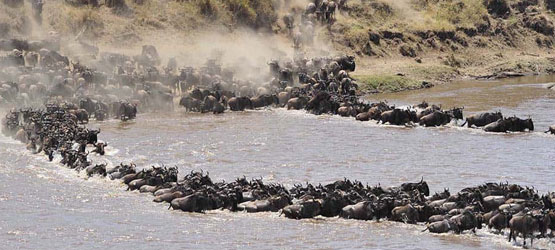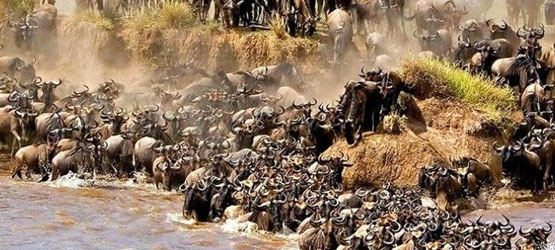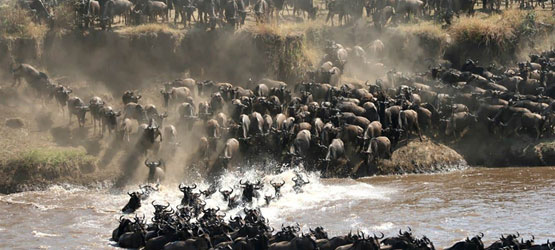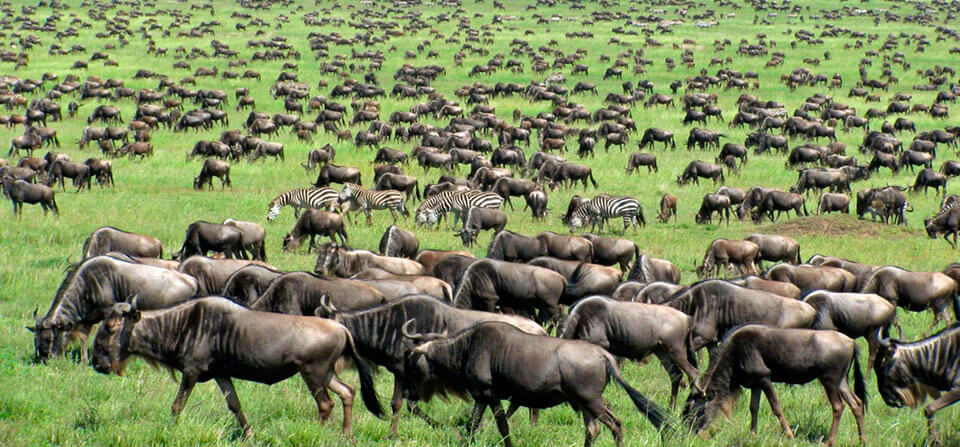Serengeti Wildebeest Migration Safari
- Home
- Tanzania Safari
- Serengeti Wildebeest Migration Safari
Serengeti Wildebeest Migration Safari: A Front-Row Seat to Nature’s Greatest Show
If you’ve ever imagined what it’s like to witness millions of animals move as one across vast African plains, you’re picturing the Great Wildebeest Migration in the Serengeti. It’s not just a safari; this is one of the most spectacular natural events on Earth. Picture this: over 1.5 million wildebeest, followed by zebras and gazelles, crossing open plains, dodging predators, and risking everything at crocodile-filled rivers. This isn’t a documentary; it’s real life, and you can be there to witness it.
From the calving grounds of Ndutu to the famous Mara River crossings, every month brings something different. Whether you’re into predator action, baby animals, or the sheer energy of the herds, there’s a perfect time and place in the Serengeti waiting for you.
What Is the Great Wildebeest Migration?
The Great Migration is a year-round, circular movement of over 2 million animals across Tanzania’s Serengeti and Kenya’s Maasai Mara. The bulk of this movement is made up of wildebeest, accompanied by around 200,000 zebras and 300,000 Thomson’s and Grant’s gazelles. This incredible journey follows the rain as the animals search for fresh grazing and water.
And they’re not alone. The migration draws out Africa’s top predators: lions, cheetahs, leopards, hyenas, and massive Nile crocodiles, which means every day on safari brings dramatic, high-stakes encounters.
Budget Camping Safaris



Best Time to Visit the Serengeti for Migration
There’s no “bad” time to go, but what you’ll see depends on when you go. Here’s a seasonal breakdown to help you plan the best time for your safari.
January – March: Calving Season (Southern Serengeti / Ndutu)
During the calving season, the flat plains makes the migration viewing all the more specular, as over a million wildebeest and Zebras are estimated to gather in the Southern plains each year. The calving season typically takes place between late January and early March, though it can sometimes be early or late, depending on the rain pattern. This is a spectacular season to visit Tanzania as you will have the opportunity to be amidst large herds of Zebras and wildebeest-as far as the eye can see. The herds between Southern Serengeti and Ndutu plains (Ngorongoro Conservation area) to give birth simultaneously. Due to the mix of volcanic soils of the Southern plains, when the rainfall occurs, a growth of highly nutritious grass that is beneficial for lactating mothers will prompt the herds of wildebeest and Zebras to feed here. As a result, this attracts large groups of predatory animals such as lions, cheetahs, leopards, and hyenas to prey on the young and the weak.With luck and exceptional guiding, you will have a chance to see a thrilling chase and stumble upon young cubs and the newborn
Over 500,000 wildebeest calves are born in just a few weeks.
Predator activity is intense; cheetahs and lions are always nearby.
Ideal for close wildlife encounters and photography.

April – May: Green Season (Central Serengeti)
April to May are known to be long rain season in Tanzania, while many may try to avoid to do safari during this period, it is in fact spectacular season to come for visit. The rainfall rejuvenates the dried-out plains, giving it a brand new, lush green coat, and the parks are transformed into a replenished haven for the animals that dwell within.The rain typically occurs in the early morning and evening, and rarely affect the game drive during the day. Due to the fact that April and May falls into the “Low season” in Tanzania, the rates are also the lowest.
As the rain moves from the Southern to the Western Serengeti, the migration herds will tread into the western corridor where they will cross the Grumeti River. While this is a relatively small crossing when compared to the Mara River Crossing into the next season, it is also one of the most highly anticipated event in the annual migration, as the Grumeti River hosts the Nile crocodile, the world’s largest crocodile, making the Crossing a risky decision for the wildebeest and Zebras
Herds start moving north.
The landscape is lush and dramatic.
Fewer crowds and lower safari rates.

June – July: Grumeti River Crossings (Western Corridor)
The Western Corridor also boasts of a diverse topography, including floodplains,Savannahs, open woodlands,scattered forests,small hills and valleys. aside from the Nile crocodiles, Western Serengeti is also home to the rare colobus monkeyslarge herds of elephants and giraffes. Resident lion prides that roam about the religion can also be seen throughout the year
In the month of June and July, the migration herds will begin to move upwards to Northern Serengeti, passing through the Grumeti reserve and Ikoma are. For those who have a longer itinerary, we would recommend spending time in both western corridor and the Kogatende area in the Northern Serengeti.
Wildebeest cross the Grumeti River, dodging giant crocodiles.
Dry season begins—great for travel and game viewing.

August – October: Mara River Crossings (Northern Serengeti)
The Northern Serengeti remains relatively pristine when compared to Seronera, Central Serengeti, as well as its counterparts, Maasai Mara in Kenya as tourists have only began to visit area in the recent years. Depending on the rain pattern, if it is a dry year then the first herds of the wildebeest can be at Mara river by early July, in a wet year, the herds would move slower arriving by mid-August. The northern Serengeti boast of many kopjes, small hills and thick woodlands which provide plenty of hiding place for the Big Cats,though the leopards are more elusive in the area. Lion and hyenas can be regularly spotted during the day, as well as cheetahs. Other resident wildlife includes hippo, giraffes, impala, topi, Thomson’s gazelle as well as large concentrations of elephants

November – December: Return to the South
As November to early December is considered low season on Tanzania, the parks are less crowded, enabling more exclusive game drives compared to the other seasons.The rainfall also makes the game viewing exciting, as it would be the first rain after a long drought during the dry season. The pricing for accommodation is also great for those who prefer to keep the cost down.
Herds begin their journey back toward the southern Serengeti.
Game viewing is still excellent, and crowds start to thin out.

Safari Preparation

Immunization and Medical Kits
Even though there are no legal immunizations to travel to Tanzania.










